Tiong Gold, the Ultimate Man of Human Voice

This is one of the birds best known to the public. In Indonesia, a kind of black starling bird with a yellow cup on his head is common in lowland forests of Sumatra and Borneo, including small islands in the vicinity to Nusa Tenggara. This bird is popular because it can mimic the human voice.
Tiong gold (in English called Common Hill Myna or Talking Myna) is spread from eastern India, southern China, Indochina, Thailand, Malaysia, and the Philippines. Forests in Java and Bali used to have this species in large numbers, but now the capture and destruction of forests causes gold tiong hard to find in nature. According to research Feare (1999) this species but has been introduced and successfully breed in other areas, especially Florida, Hawaii, Japan, to Puerto Ric0.
The international convention of endangered species (CITES) notes the bird named Latin Gracula religiosa is widely traded in large numbers in domestic and international markets. "One of the gold tiong chicks that many hunted in Indonesia is gold tiong from Nias known by the community with the name of the nias beo," said Jihad, Bird Conservation Officer Bird Indonesia.
If gold is capable of imitating human voices, the secret lies in the syrinx that this bird possesses. This syrinx resembles the human throat. On the syrinx wall there is a cartilage bulge called an external labium. One of the external labium works like a human vocal cord and is responsible for supplying sound producing energy.
As a result, gold is able to produce a series of different sound tones such as whistles, screams, rattles, even loud melodies and sometimes sounds like human voices. Each gold individual has three to 13 types of sound.
Uniquely, the golden population of 14-15 km does not have a similar type of sound, meaning that within that span of gold the population can not imitate the vocal sounds that neighbors create.
Unlike the stone sculpture (Dicrurus paradiseus) which often imitate the sound of other bird species, gold does not do it. But in captivity, golden tiong has a remarkable ability to learn and imitate sounds, especially human voices.
In nature, the golden wedding season varies slightly, but most breed in April-July. A pair of monogamy looking for a small hole in the tree at the edge of the forest. The birds fill the holes with twigs, leaves and feathers. Females produce an average of 2 eggs that are blue with brownish spots.
Generally gold tiong live in hilly areas between 300 to 2000 m above sea level. These birds choose habitats that have high rainfall and humidity, including tropical rain forest ecosystems. In some places, it is reported that these birds can also live on the edge of the forest, cultivated plantation areas such as coffee and other forest gardens.
"This amazing golden ability has caused many humans to chase after him. They are competing to have this bird for themselves, "said Jihad.
In addition to habitat destruction that degrades the golden population in nature, catching and hunting for trading to the international market causes its population to decline throughout its span range.
In this article of cooperation between Mongabay-Indonesia and Burung Indonesia in January 2016, you can download digital calendar for your gadget or computer. Please click this link and save it in your device.
